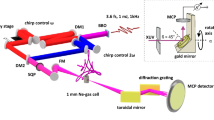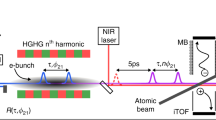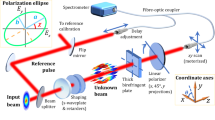Abstract
Probing the vectorial properties of light–matter interactions inherently requires control over the polarization state of light. The generation of extreme-ultraviolet attosecond pulses has opened new perspectives in measurements of chiral phenomena. However, limited polarization control in this regime prevents the development of advanced vectorial measurement schemes. Here, we establish an extreme-ultraviolet lock-in detection scheme, allowing the isolation and amplification of extremely weak chiral signals, by achieving dynamical polarization control. We demonstrate a time-domain approach to control and modulate the polarization state, and perform its characterization via an in situ measurement. Our approach is based on the collinear superposition of two independent, phase-locked, orthogonally polarized extreme-ultraviolet sources and the control of their relative delay with sub-cycle accuracy. We achieve lock-in detection of magnetic circular dichroism, transferring weak amplitude variations into a phase modulation. This approach holds the potential to significantly extend the scope of vectorial measurements to the attosecond and nanometre frontiers.
This is a preview of subscription content, access via your institution
Access options
Access Nature and 54 other Nature Portfolio journals
Get Nature+, our best-value online-access subscription
$29.99 / 30 days
cancel any time
Subscribe to this journal
Receive 12 print issues and online access
$209.00 per year
only $17.42 per issue
Buy this article
- Purchase on Springer Link
- Instant access to full article PDF
Prices may be subject to local taxes which are calculated during checkout




Similar content being viewed by others
Data availability
The data that support the plots within this paper and other findings of this study are available from the corresponding author upon reasonable request.
References
Berova, N., Nakanishi, K. & Woody, R. Circular Dichroism: Principles and Applications (Wiley, New York, NY, 2000).
Calegari, F., Sansone, G., Stagira, S., Vozzi, C. & Nisoli, M. Advances in attosecond science. J. Phys. B 49, 062001 (2016).
Corkum, P. B. Plasma perspective on strong field multiphoton ionization. Phys. Rev. Lett. 71, 1994–1997 (1993).
Budil, K., Salières, P., L’Huillier, A., Ditmire, T. & Perry, M. Influence of ellipticity on harmonic generation. Phys. Rev. A 48, R3437–R3440 (1993).
Antoine, P., Carré, B., L’Huillier, A. & Lewenstein, M. Polarization of high-order harmonics. Phys. Rev. A 55, 1314–1324 (1997).
Fleischer, A., Kfir, O., Diskin, T., Sidorenko, P. & Cohen, O. Spin angular momentum and tunable polarization in high-harmonic generation. Nat. Photon. 8, 543–549 (2014).
Kfir, O. et al. Generation of bright phase-matched circularly-polarized extreme ultraviolet high harmonics. Nat. Photon. 9, 99–105 (2015).
Fan, T. et al. Bright circularly polarized soft X-ray high harmonics for X-ray magnetic circular dichroism. Proc. Natl Acad. Sci. USA 112, 14206–14211 (2015).
Zhou, X. et al. Elliptically polarized high-order harmonic emission from molecules in linearly polarized laser fields. Phys. Rev. Lett. 102, 073902 (2009).
Mairesse, Y. et al. High harmonic spectroscopy of multichannel dynamics in strong-field ionization. Phys. Rev. Lett. 104, 213601 (2010).
Skantzakis, E. et al. Polarization shaping of high-order harmonics in laser-aligned molecules. Sci. Rep. 6, 39295 (2016).
Ferré, A. et al. A table-top ultrashort light source in the extreme ultraviolet for circular dichroism experiments. Nat. Photon. 9, 93–98 (2015).
Gruson, V. et al. Interferometric control of the ellipticity of a femtosecond extreme ultraviolet source. J. Opt. Soc. Am. B 35, A15–A21 (2018).
Höchst, H., Patel, R. & Middleton, F. Multiple-reflection λ4 phase shifter: a viable alternative to generate circular-polarized synchrotron radiation. Nucl. Instrum. Methods Phys. Res. A 347, 107–114 (1994).
Vodungbo, B. et al. Polarization control of high order harmonics in the EUV photon energy range. Opt. Express 19, 4346–4356 (2011).
Depresseux, A. et al. Demonstration of a circularly polarized plasma-based soft-X-ray laser. Phys. Rev. Lett. 115, 083901 (2015).
Schmidt, J., Guggenmos, A., Hofstetter, M., Chew, S. H. & Kleineberg, U. Generation of circularly polarized high harmonic radiation using a transmission multilayer quarter waveplate. Opt. Express 23, 33564–33578 (2015).
Ellis, J. L. et al. High harmonics with spatially varying ellipticity. Optica 5, 479–485 (2018).
Hickstein, D. D. et al. Non-collinear generation of angularly isolated circularly polarized high harmonics. Nat. Photon. 9, 743–750 (2015).
Huang, P.-C. et al. Polarization control of isolated high-harmonic pulses. Nat. Photon. 12, 349–354 (2018).
Miao, J., Ishikawa, T., Robinson, I. K. & Murnane, M. M. Beyond crystallography: diffractive imaging using coherent X-ray light sources. Science 348, 530–535 (2015).
Kfir, O. et al. Nanoscale magnetic imaging using circularly polarized high-harmonic radiation. Sci. Adv. 3, eaao4641 (2017).
Nahon, L., Garcia, G. A. & Powis, I. Valence shell one-photon photoelectron circular dichroism in chiral systems. J. Electron. Spectros. Relat. Phenom 204, 322–334 (2015).
Rabinovitch, K., Canfield, L. & Madden, R. A method for measuring polarization in the vacuum ultraviolet. Appl. Opt. 4, 1005–1010 (1965).
Huang, P.-C. et al. Generation and characterization of isolated, circularly polarized, attosecond pulses. In The European Conference on Lasers and Electro-Optics, CG_1_5 (Optical Society of America, 2017).
Jiménez-Galán, Á. et al. Attosecond recorder of the polarization state of light. Nat. Commun. 9, 850 (2018).
Veyrinas, K. et al. Molecular frame photoemission by a comb of elliptical high-order harmonics: a sensitive probe of both photodynamics and harmonic complete polarization state. Faraday Discuss. 194, 161–183 (2016).
Chen, C. et al. Tomographic reconstruction of circularly polarized high-harmonic fields: 3D attosecond metrology. Sci. Adv. 2, e1501333 (2016).
Valencia, S. et al. Faraday rotation spectra at shallow core levels: 3p edges of Fe, Co, and Ni. New J. Phys. 8, 254 (2006).
McNulty, I. et al. High-resolution imaging by Fourier transform X-ray holography. Science 256, 1009–1012 (1992).
Popmintchev, T. et al. Bright coherent ultrahigh harmonics in the keV X-ray regime from mid-infrared femtosecond lasers. Science 336, 1287–1291 (2012).
Beaulieu, S. et al. Attosecond-resolved photoionization of chiral molecules. Science 358, 1288–1294 (2017).
Acknowledgements
The authors thank R. Naaman, A. Capua, T. Ruchon and S. Beaulieu for helpful discussions, S. Valencia Molina for providing the synchrotron data and E. Capua and G. Leitus for performing the superconducting quantum interference device measurement. N.D. is the incumbent of the Robin Chemers Neustein Professorial Chair. N.D. acknowledges the Minerva Foundation, the Israeli Science Foundation, the Crown Center of Photonics and the European Research Council for financial support. M.K. acknowledges financial support by the Minerva Foundation and the Koshland Foundation. This project has received funding from the European Research Council under the European Union Horizon 2020 research and innovation program 682978, EXCITERS.
Author information
Authors and Affiliations
Contributions
N.D. supervised the study. D.A. designed and built the experimental set-up. D.A., O.K. and M.K. carried out the measurements and analysed the data. B.D.B. supported the operation of the laser system. All authors discussed the results and contributed to writing the manuscript.
Corresponding author
Ethics declarations
Competing interests
The authors declare no competing interests.
Additional information
Publisher’s note: Springer Nature remains neutral with regard to jurisdictional claims in published maps and institutional affiliations.
Supplementary information
Supplementary Information
This file contains more information on the work, Supplementary Table 1 and Supplementary Figures 1–6.
Rights and permissions
About this article
Cite this article
Azoury, D., Kneller, O., Krüger, M. et al. Interferometric attosecond lock-in measurement of extreme-ultraviolet circular dichroism. Nature Photon 13, 198–204 (2019). https://doi.org/10.1038/s41566-019-0350-5
Received:
Accepted:
Published:
Issue Date:
DOI: https://doi.org/10.1038/s41566-019-0350-5
This article is cited by
-
Sub-cycle multidimensional spectroscopy of strongly correlated materials
Nature Photonics (2024)
-
Topological high-harmonic spectroscopy
Communications Physics (2024)
-
Enabling elliptically polarized high harmonic generation with short cross polarized laser pulses
Scientific Reports (2023)
-
Direct measurement of Coulomb-laser coupling
Scientific Reports (2021)



